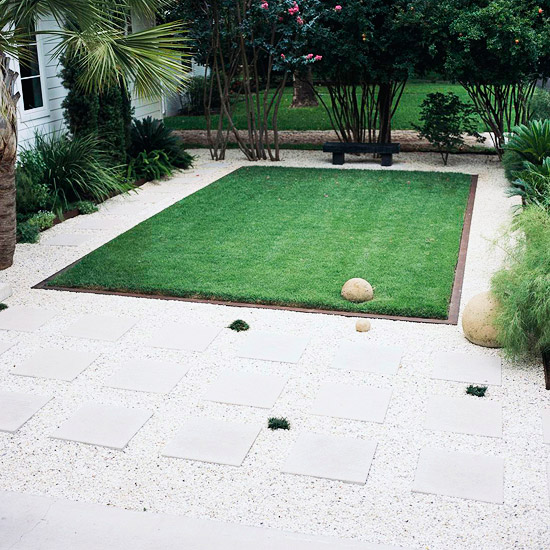






Note: Because of this region's climate conditions, a lawn may not be the most budget-friendly or environmentally responsible choice. Check with your county's cooperative extension service to find out if a lawn makes sense in your area.
continue reading belowPrevent summer weeds: Annual weeds, such as crabgrass, grow from seed. Use a well-timed application of pre-emergence herbicide to stop them from growing at all. A good general guideline is to spread the pre-emergence herbicide from mid-February to early March.
Cut the grass: The general rule for mowing is to never cut off more than one-third of the grass's height. Start cutting it as it begins to grow in late spring. Start mowing once your grass reaches about 3 inches tall. Keep most cool-season grasses about 2 inches tall -- this helps the grass ward off weeds and withstand summer drought. Don't remove more than one-third of the leaf length in one mowing.
Take care of thatch: If a layer of thatch, or old, dead grass stems builds up, the best time to remove it is before the grass really starts growing in summer. Remove thatch so that air and water can more easily reach your grass roots.
Get your mower ready: Let the lawn-care season start by taking care of your mower. Bring your mower in for service in early spring; you'll beat the rush so your mower is in tip-top shape when you need to start cutting your grass. Don't forget to sharpen the blade of your mower at least once a year. A sharp blade will keep your lawn looking healthy and can prevent some disease issues.
Sharpen Your Lawn Mower Blade
Prevent crabgrass problems: Crabgrass and other annual weeds sprout each year from seed. Stop this lawn pest with a well-timed application of pre-emergence herbicide. Spread the pre-emergence herbicide as forsythia blooms start to drop.
Aerating: If your lawn doesn't grow well due to compacted soil, spring -- when your grass starts actively growing -- is a great time to aerate. This loosens the soil, allowing grass roots to reach deeper and the soil to absorb moisture better.
Fertilizing: If you feed your lawn a couple times a year, a light application of fertilizer will help get your lawn off to a great start. Keep it light and select a slow-release or organic fertilizer. Fertilize when your lawn needs mowing for the first time; don't feed it earlier.
Apply fertilizer: Warm-season lawns like best when temperatures get hot. Start feeding as the mercury starts to rise in late April or early May. Feed according to the fertilizer package instructions through the summer.
Stop grubs: If grubs have been a problem in your lawn or in your area, use a long-acting grub killer in early May.
Start a new lawn: Whether you use seed, sprigs, or plugs, start your lawn in summer. Remember that new lawns need plenty of water as they get established; never allow them to dry out.
Continue mowing: Most grasses do their best once it warms up, so mow regularly. Watch how your lawn grows. During hot, dry periods, it may only need mowing once every two or three weeks (when it reaches about 3 inches tall). During cooler, moister periods, it may need mowing twice a week.
Aerate compacted soil: Most lawns have trouble growing in compacted soil (many weeds, unfortunately, thrive in it). Aerate in the summer when your grass is growing the fastest.
Watering: Most lawns will require regular watering during the summer to keep them green. Providing about 1 inch of water per week is typically necessary. It's fine to let your grass go dormant during drought. It'll turn brown, but it will stay alive and then go green and start growing when the rains come again. If you don't want a brown summer lawn, select drought-tolerant types or plan on giving your lawn about 1 inch of water a week.
Mowing: Keep mowing your lawn as it slows down. Keep in mind that as temperatures cool and your grass goes dormant that you may not have to mow as frequently.
Prevent winter weeds: Stop annual weeds from growing during the winter by using a pre-emergence herbicide to stop them from growing. Typically, you'll need to apply the product from mid-October to mid-November.
Overseed with annual ryegrass: Because Bermudagrass goes dormant and turns brown in the winter months, many people like to overseed with annual ryegrass. The grass will grow and stay green during the cooler months, then die out once it gets hot and regular turf grass starts growing again. If you overseed your lawn, you'll need to keep mowing all winter.
Fertilizing: Fall is the best time to feed your lawn. Feed your lawn in early fall and again in late autumn.
Clean up: Clean up fallen leaves. Here's a time-saving tip: Instead of raking up the leaves, run them over with your lawn mower several times. You'll chop up the leaves into fine pieces; they'll decompose and add to your soil's structure.
More About Overseeding Your Lawn
Find your average first frost fate
Attack perennial weeds: Perennial weeds are most susceptible to attack in autumn; attack them with a broad-leaf herbicide.
More About Lawn Weeds
Aerating: Cooler autumn temperatures mean your grass will start growing more again -- so it's also a great time to aerate to loosen compacted soil.
Copyright © www.100flowers.win Botanic Garden All Rights Reserved